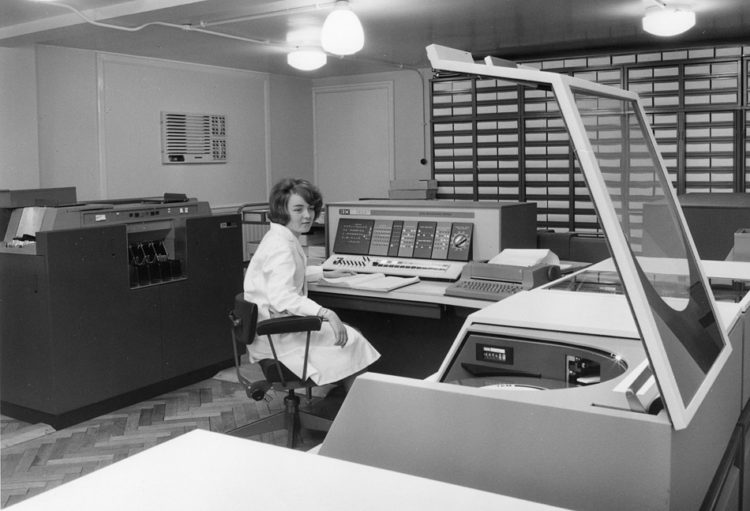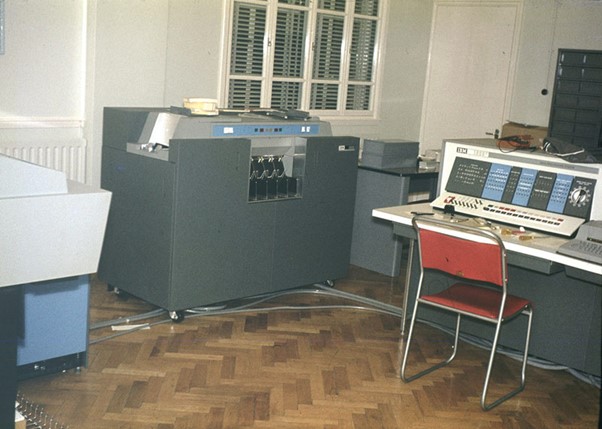The first computer operator
On the 4th January 1965 the University of St Andrews Computing Laboratory started a full-time computer service in St Andrews. In celebration of its Silver Jubilee in 1990, the Computing Lab issued a special supplement to its newsletter. Below are the final parts of the newsletter written by the first computer operator, Sheila Hill and the newsletter editor, Peter Adamson.
The first computer operator
by Mrs Sheila Hill

The job was so new that it took the University two years to decide on the appropriate post for my job. It fitted in neither as a secretary/typist nor yet a technician! Perhaps a “Misfit”? I was first employed in a secretarial grade which caused problems when I was asked for my shorthand and typing qualifications. I had none! Then an extra increment was announced at the top of the scale for those who operated accounting machines. Would I be eligible? Apparently not as operation of an accounting machine was a special responsibility. It took some correspondence with College Gate to demonstrate that operation of a £135,000 computer was a position with at least the responsibility of that of an accounting machine operator! I ended up after 2 years as a Senior Technician, a promotion I treasured.
Well what happened in between? I had a wee office beside the computer which was housed on the ground floor of the Scott Lang Building of the Observatory. I was proudly equipped with a telephone, desk, waste paper basket and an air vent for which I was eternally grateful.
The computer itself was a challenge to operate. For it had so many peripherals – I can now spell this word some 25 years later! The typewriter received messages fairly reliably but it had a golf ball head which was a novelty to me. Typewriter and printer ribbons were the bane of my life. For there were many occasions when our dear friend ‘Ossie’ Wake, the IBM engineer, would be needed to untangle the ribbon and replace/reset the printer characters. In fact Ossie was called so many times because the printer would collapse under the strain of users’ long outputs like those of Colin Thomson, let alone Tony Davie’s!
We collected boxes of half-used printer paper when it went madly out of control, and, even when told politely to stop, it forced me to turn the power off before we all went mad! Thinking of maddening operations I recall the Card Reader. This machine needed cards in perfect condition and if anyone had punched their own header card badly it would jam up the works causing untold losses of temper, particularly amongst student users at the 11 am and 4 pm “Program Testing Times”.
The disk drives were a fascination to us all. To avoid the obvious, i.e. loss of vital information, we regularly copied disk packs so that we had a reserve set. For in the early days it was easy to wipe off other users’ data if it wasn’t stored correctly. The graph plotter was a great blessing (it worked!) and indeed a fascination. We had a large amount of equipment which made quite a din and generated a lot of heat which often caused us trouble with the air conditioning system. We often worked in temperatures of over eighty degrees with a system that was new to us. I shall never forget the queues of users at “Testing Time” when they would bring their programs to be run by us. If there were relatively easy syntax errors we would correct them on the spot. As the temperature rose so did tempers when cards jammed, paper went out of control or the typewriter jammed. Despite all the frustrations the challenge was most exciting and I am very grateful I was given this rare opportunity of serving the University.”

Postscript . . .
By P G Adamson, Newsletter Editor
“On a personal note, I am particularly pleased to have been able to present some idea of the special qualities of the IBM 1620 which gave me many happy hours of programming work, especially its peculiar architectural features – its indirect addressing and variable-length fields, its flags and record marks, its graph-plotter and its disk-based operating system, and no tapes (paper or magnetic). With such a machine, it was so easy to get away from the usual data-processing and “souped-up numerical analysis” image of computing prevalent in those days, and to consider instead graphical work and text manipulation which are so important a part of present-day computing.
The real difficulty was of course lack of processing power: since instructions generally each took at least 60 microseconds (that was just to read in the op-code and two addresses), it was possible to watch the flashing lights indicating the instructions performed and to get a good idea which part of your program was being processed – notably if it had got stuck in a loop. This was especially true if very long fields were being operated on: one trick was to enter a short program which alternately added and subtracted the contents of one half of memory to and from the other half (that is, manipulating two integers of up to 30,000 digits each); the subsequent slow flashing and rippling of op-code and address lights was quite gratifying, and somehow reduced high-speed electronic computation to a more human rate (but also tended to over-write the Supervisor system program which then had to be reloaded . . .) The lack of memory was very much ameliorated by the efficiency of variable-length fields – if your integer needed only two digits, it was possible to use only two. I always felt (and still do) that the change to the IBM 360 was in some ways a backward step – notwithstanding the introduction of magnetic and paper tapes and the 60-fold increase in processor speed: the fixed word-length, no indirect addressing and hexadecimal seemed not much of an advance! Even the peripherals seemed not such an improvement: the new card reader was at first no faster and the card punch was a good deal slower – and of course punched cards were a primary medium in those days.
From the 1620 days, I have fond memories of dropped card decks, of the printer operating with one cover off and a fan blowing at a section the engineers couldn’t fix properly, printer type segments getting caught in the ribbon; of waiting during “testing time” in amazing heat for my job to run, and of course of typing 4900796 on the console typewriter – this branched back to the Supervisor program when all else failed and your program had got stuck in a loop or one of the operators had decided that you’d had enough time on the machine! Then there was the lecturer who used cards with pre-cut holes which could be poked out by hand by students taking a multiple-choice exam; as it was possible also to correct mistakes using small self-adhesive patches, you may imagine the chaos produced in the card reader. And there were users who made the computer do really useful (?) things – like playing three-dimensional noughts-and-crosses on the console typewriter (due to a bug, the 1620 always won) or making the graph plotter hum Christmas carols (really!); or the psychologist who regularly submitted (from another university) a job which slowly and painfully with tremendous calculations drew a very large equilateral triangle. There remains also a vivid impression of Professor Cole personally and patiently reconstructing disk space allocation tables after careless users had precipitated one of the periodic system tangles . . .”
It's fascinating to hear about your personal experiences with the IBM 1620, particularly its unique architectural features and the challenges and gratifications that came with programming on such a machine. Your insights into the contrast between the IBM 1620 and the IBM 360 highlight the evolution of computing technology and the trade-offs involved in different design approaches. It's also intriguing to learn about the programming tricks, like the one involving alternating additions and subtractions, that you employed to interact with the machine's limitations. Your reflections provide a valuable glimpse into the early days of computing and the passion that drove programmers like yourself to explore its potential.